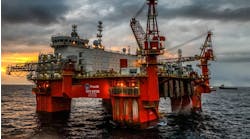With all the recent discussion about revitalization on the North Sea, a new study published by venture capital company 3i points out that the movement of independent operators into the North Sea still has a long way to go before it can turn the region around. The time when these properties were a bargain and any operator who bought in could make a profit just by managing late-in-life production is over. Any advantages smaller operators hope to have going forward will be hard won in what has shaped up to be a competitive market.
The North Sea is a tightly held market, according to the 3i report The Prospects for North Sea Oil and Gas – Challenge and Opportunity in a Maturing Province. The report states that eight companies command 75% of the UK North Sea assets and infrastructure (a grip that is even tighter on Norwegian assets). 3i Oil & Gas Director Graeme Sword said these companies are not planning to leave such an affluent market in the near future.
While the North Sea is a profitable "cash cow" for the supermajors, it is not a priority for new investment. Many industry experts now argue that the impetus to reinvigorate North Sea oil production will have to come from elsewhere, Sword said. Yet this has been slow to happen. According to Sword, only one new independent has entered the North Sea market each year over the last decade. And these entries have been very modest, with companies taking over production of one or two assets per year.
With the high potential in this market, why has the move been so tentative? Sword said the North Sea has seen a lot of "me-too" entrants – companies that take over late-in-life production, but do little to revitalize the fields. As a result, these fields continue to produce at the declining level, and the savings for the new operator come from cutting overhead.
Independents argue that the UK regulatory market is not conducive to new entrants. The structure seems to favor the super majors by allowing them to sit on assets as long as they like, with no obligation to produce the properties. If the sector is serious about a renaissance, the regulatory policies should reflect this priority. In fairness, some steps have been taken, according to the report.
In the UK, a new discounted licensing program called Promote gives companies two years to assess the value of a field before committing to its production. According to the report, this led to a record high of 27 new entrants to the North Sea during the 2003 licensing round.
To succeed, Sword said, the independents need to apply more differentiated business models. The Fallow Initiative, another new UK incentive program, seeks to rejuvenate activity in dormant fields by allowing third parties to propose technical ideas that would stimulate new exploration and development. The problem is that the independents often tie up all of their capital acquiring a property. There is little left for the application of new, and expensive, technology. These companies need early returns on their investment to rebuild capital reserves. On the other hand, the majors are not applying their new technology to North Sea fields. They are directing these resources to frontier developments in areas such as West Africa, where there is a greater potential for world-class finds.
Herein lies a direct and critical challenge to the future health of the independent E&P sector, Sword said in the report. The challenge is to find a new economic model that will enable smaller firms to acquire assets at prices that can generate higher returns.
One example of this is an innovative business model, brought forward by Energy Development Partners (EDP). It aims to partner with existing asset owners and take technical control of projects without owning the asset directly. The model creates value by investing technical expertise and capital to increase the producing life of an asset. Sword explains that EDP would earn returns as a share of the incremental value achieved as a result of enhanced and extended production. This strategy avoids many of the typical barriers to entry faced by new companies, Sword said, such as setting aside capital for decommissioning liabilities and winning ownership of assets in expensive and often highly competitive auctions.
As more North Sea assets become available, the effective entry price for new players should fall. In the meantime; however, the acquisition market remains highly competitive, with a limited flow of assets being chased by a significant pool of buyers. Without creative business models, the independents will continue to play a limited role in the North Sea, to the determent of the entire industry.
William Furlow


